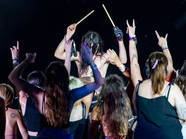Mathematical Creation and Re-creation
Conferences, meetings, musical performances, mathematical games, exhibits, and films all focused on the logical discourse of mathematics. was the scientific director of the third annual event, and i-Italy’s correspondent Flavia Bagni had the opportunity to interview him two weeks ago.
He also coordinated the Fondazione Musica per Roma event which took place in both cities thanks to financial support from Italy’s president.
The province of Rome promoted the initiative along with private organizations such as Enel, Telecom, and Lottomatica. The president of the province, Nicola Zingaretti, underlined the importance of the event which presented mathematics as a “strategic resource” and “the primary means of planning for the future.”
Paolo Giordano, a 27-year old physician and writer who is not a mathematician, opened the festival on March 19. He won the Premio Strega in 2008, Italy’s prestigious prize for literature for his novel Le Solitudini dei numeri primi. During the lecture, he read his short story “Evariste Galois’ Last Night” which is about an unruly genius mathematician who died in 1832 at a very young age in Paris. The night before he died, he recorded the theorems that formed the nucleus of what posterity would call Galois’ Theory.
The title “Creation and Re-Creation” conveys the event’s double identity. On the one hand, it refers to the world’s most creative geniuses such as the three Fields medal winners and the eight Nobel Prize winners who participated in the conference. On the other hand, it refers to the re-creation that took place at the event’s lectures, games, exhibits, and films which captured mathematics’ playful side.
Among the lectures I attended, I had a definite sense of being a fish out of water at the one held by Richard Ernst who won the Nobel Prize for Chemistry in 1991 for magnetic resonance, nuclear magnetic resonance (NMR), and electron paramagnetic resonance (EPR). The scientist, however, was able to address the audience in a personal and ironic way while unveiling a powerful tool for the exploration of scientific phenomena found in nature. Using the metaphor of the tree of knowledge, mathematics is not merely a minor branch on the science tree (along with medicine, biology, chemistry, and physics) but it is a fundamental, vital instrument without which the tree would not be able to flourish.
These extraordinary and scholarly sessions were balanced by game shows geared at both adults and children to introduce the subject of math in a non-threatening way. One of these games called “No More Fear of Math” took place on March 21 in the afternoon, and was run by Giovanni Filocamo, a young physician and a science promoter who presented the subject as it really is: a game. Math can reflect our character and our behavior in such a way that our entire personality comes into play; our fear, lack of confidence, and uncertainty all play a decisive role in whether we succeed in math or not. Children were front and center at this event!
Another session took place on March 21 in the evening and was chaired by Riccardo Chiaberge, an editor at Il Corriere della Sera. It focused on cultural and scientific issues facing the newspaper Il Sole 24 Ore where he also edits the third page and the supplement “Domenica.”
Chiaberge moderated the discussion between the Nicola Cabibbo, president of the Pontifical Academy of Sciences and physics professor, and Arno A. Penzias, winner of the Nobel Prize for Physics in 1978, while giving an historical and critical overview on the relationship between science and faith. The rationalist skeptic Penzias and the Catholic Cabibbo told two different stories and presented two very different cultural and religious points of view, but they managed to agree on the inconsistency and incompleteness of numbers – that is, the impossibility for numbers to completely determine the outcome of natural events on their own.
On Sunday, March 22 in the Sinopoli Room, Professor and PhD in Mathematics Education Bruno D’Amore explained the connection between mathematics and figurative art during a lecture entitled Perspective and Beyond: From Brunelleschi to Reutersvärd. The lecture was related to the exhibit of work by Oscar Reutersvärd entitled Figure Impossibili, which was curated by Bruno D’Amore and was on display at the Auditorium Arte.
The history of mathematics runs parallel to other discoveries of the human mind. D’Amore explored the fascinating link between perspective and the visual arts beginning with Giotto and continuing to the present day. In particular, he explained how artists have been using perspective throughout history, at times consciously and at other times unconsciously and without real scientific knowledge. It was only during the Renaissance when perspective was applied to art in a mathematical and effective way.
The audience was not at all passive during his lecture, and teachers, artists, and mathematicians all eagerly participated in order to satisfy their curiosity and gather advice on how to involve their own students.
After the lecture and before closing the festival, President Nicola Zingaretti delivered a special, first-annual award to the mathematician John Nash in recognition of “a beautiful mind.”
Although I had first arrived at the mathematics festival as a fish out of water, by the festival’s end I had acquired an in-depth appreciation for the subject and even discovered a deeper interest in learning more. Most importantly, I faced my own fears and uncertainties with respect to mathematics.
The cooperation between the two host cities could become the basis for an ongoing series of collaborative events with other international cultural centers “in order to share experiences and show the world what Italy is capable of, while entertaining and inspiring audiences,” in the words of Mr. Carlo Fuortes himself, CEO of Fondazione Musica per Roma.
(Edited by Giulia Prestia)












































i-Italy
Facebook
Google+
This work may not be reproduced, in whole or in part, without prior written permission.
Questo lavoro non può essere riprodotto, in tutto o in parte, senza permesso scritto.